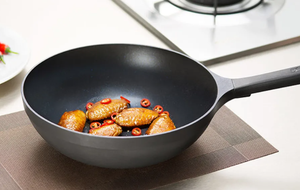
Wok Inspection Details Inspection and Certification Services for Warehousing and Factory Audits
As the core cooking utensil in the kitchen, the quality and safety of the wok directly affect food safety and the cooking experience. To ensure that the products meet national quality standards and certification requirements, establishing a professional inspection process is of vital importance. This article will systematically introduce the inspection standards, testing methods and certification requirements for wok products, providing a complete quality control guide for enterprises.
1. Appearance quality inspection certification standards
1. Surface quality certification
There should be no defects such as cracks, unevenness, pores, scratches, burrs, unpleasant odors, or dirt on the surface.
During the inspection process, a comprehensive visual examination must be conducted to ensure compliance with the acceptance standards.
2. Trachoma Defect Certification
Quantity Limit: No more than 3 trachoma cases per pot of noodles
Spacing requirement: Distance between eyes ≥ 10 cm
Size standard: The area of a single cataract should be ≤ 0.3 mm² and the depth should be ≤ 0.1 mm.
Inspection distance: Measured distance ≤ 40 cm
3. Surface treatment certification
The inner and outer surfaces are uniformly coated with edible-grade oil film.
Certification of high-temperature baking process at 280℃
No signs of sand eye, rust, dirt, or oil stains.
4. Structural Stability Certification
Flatness test of the bottom of the pot, with no shaking when combined with the microcrystalline glass plate
Test for the firmness of the handle installation, with no loosening phenomenon.
The structural integrity test for obtaining the factory inspection certification
II. Dimension Accuracy Inspection Certification Standards
1. Dimension Tolerance Certification
Bottom diameter of the pot: d ± 4mm
Bottom of the pot height: H ± 1mm
Diameter of the pot body: D ± 1mm
Edge thickness of the pot: ≥ 1.3mm
Certification basis: Conduct comparative tests by referring to the sample provided for reference.
2. Weight standard certification
Carried out strictly in accordance with the technical drawings or technical agreements.
Establish a weight tolerance inspection and certification system
During the inspection process, weight sampling tests are carried out.
III. Performance Reliability Testing and Certification
1. Sealing Performance Certification
There is no leakage at the riveted joints.
Passing the professional water-tightness test through inspection
2. Structural Strength Certification
Load Test: Fill the pot with 90% of the water capacity, hold it by hand for 2 minutes.
Acceptance criteria: Handle should not come off, screws should not be loose.
Complies with the structural durability requirements for factory inspection certification
3. Impact Resistance Certification
Drop Test: Drop from the specified height onto a horizontal cement/stone floor.
Quality requirements: The pot body should have no cracks or splits.
Passed the impact test certification by a third-party inspection agency
4. Lifespan Certification
Durability Test: Fill with water and continuously cook on the induction cooker for 300 hours.
Inspection frequency: Sampling inspection is conducted once every three months.
Certification standard: Free from quality defects such as cracking or leakage.
IV. Marking and Packaging Inspection Certification
1. Transportation Packaging Certification
Verification of transportation reliability, assessment of packaging rationality
Special paper sheet isolation protection to prevent cracking and injury
The packaging safety test that has passed the inspection and certification
2. Warehouse Condition Certification
Storage environment: Well-ventilated, dry, and cool warehouse
Establish a standardized warehousing management system
Compliant with the warehouse environment standards for factory inspection certification
3. Identification Information Verification
Packaging labels: Product name, quantity, production batch number
Enterprise Information: Manufacturer's Name and Certification Documents
Certification requirements: Comply with the relevant regulations of the Food Hygiene Law
V. Inspection and Certification Process Standards
1. Sampling Inspection Plan
Implement statistical sampling in accordance with the GB/T standards
Safety-critical projects implement a full inspection system.
Establish a complete quality traceability system
2. Requirements for testing environment
Standardized laboratory environment for testing
Use calibrated and qualified testing equipment
Strictly follow the inspection and certification operation procedures
3. Defect Level Determination
Serious Defect: Any item that affects the safety of use will not be tolerated.
Main defect: Quality issue that reduces product performance
Minor defect: The appearance flaws fall within the acceptable range as per the standards.
VI. Key Control Matters for Factory Audit
To ensure that the quality of the frying pans consistently meets the certification requirements, during the factory audit process, the following key points need to be focused on:
Raw material control: Establish a certification system for food-grade material suppliers
Production process control: Develop operation specifications for key processes such as stamping, polishing, and coating.
Calibration of testing equipment: Regularly calibrate all measuring instruments
Health management certification: Compliant with hygiene standards for food contact materials
Personnel qualification certification: Professional training and certification for quality inspection personnel
Inspection and Certification Summary
The inspection and factory verification of frying pans is a comprehensive systematic project involving material safety, structural strength, and performance. By establishing a professional inspection process and strict quality standards, enterprises can ensure that frying pan products meet the requirements of food contact material certification, providing consumers with safe, durable, and healthy cooking utensils.
Share this product

Wok Inspection Details Inspection and Certification Services for Wareh
As the core cooking utensil in the kitchen, the quality and safety of the wok directly affect food safety and the cooking experience.
